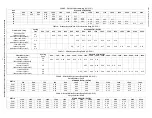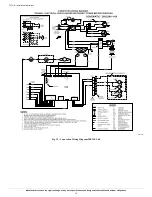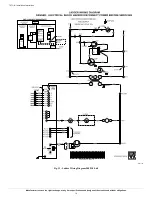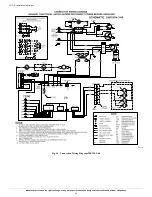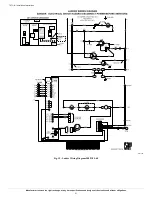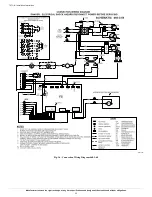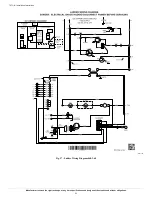
707C--K: Installation Instructions
Manufacturer reserves the right to change, at any time, specifications and designs without notice and without obligations.
8
IMPORTANT:
Use flexible connectors between ductwork and unit to
prevent transmission of vibration. Use suitable gaskets to ensure
weather-tight and airtight seal. When electric heat is installed, use
fireproof canvas (or similar heat resistant material) connector between
ductwork and unit discharge connection. If flexible duct is used, insert a
sheet metal sleeve inside duct. Heat resistant duct connector (or sheet
metal sleeve) must extend 24-in. (610 mm) from electric heater element.
3. Size ductwork for cooling air quantity (cfm). The minimum air
quantity for proper electric heater operation is listed in
.
Heater limit switches may trip at air quantities below those
recommended.
4. Seal, insulate, and weatherproof all external ductwork. Seal,
insulate and cover with a vapor barrier all ductwork passing
through conditioned spaces. Follow latest Sheet Metal and Air
Conditioning Contractors National Association (SMACNA) and
Air Conditioning Contractors Association (ACCA) minimum
installation standards for residential heating and air conditioning
systems.
5. Secure all ducts to building structure. Flash, weatherproof, and
vibration-isolate duct openings in wall or roof according to good
construction practices.
Configuring Units for Downflow (Vertical) Discharge
1. Open all electrical disconnects and install lockout tag before
starting any service work.
2. Remove horizontal (metal) ductcovers to access vertical
(downflow) discharge duct knockouts in unit basepan. (See
.)
To remove downflow return and supply knockout covers, break front and
right side connecting tabs with a screwdriver and hammer. Push cover
down to break rear and left side tabs.
NOTE:
These panels are held in place with tabs similar to an electrical
knockout. Reinstall horizontal duct covers (
) shipped on unit from
factory. Insure openings are air and watertight.
NOTE:
The design and installation of the duct system must be in
accordance with the standards of the NFPA for installation of
nonresidence-type air conditioning and ventilating systems, NFPA 90A
or residence-type, NFPA 90B; and/or local codes and ordinances.
Adhere to the following criteria when selecting, sizing, and installing the
duct system:
1. Units are shipped for side shot installation.
2. Select and size ductwork, supply-air registers, and return-air grilles
according to American Society of Heating, Refrigeration and Air
Conditioning Engineers (ASHRAE) recommendations.
3. Use flexible transition between rigid ductwork and unit to prevent
transmission of vibration. The transition may be screwed or bolted
to duct flanges. Use suitable gaskets to ensure weather-tight and
airtight seal.
4. All units must have field-supplied filters or accessory filter rack
installed in the return-air side of the unit. Recommended sizes for
5. Size all ductwork for maximum required airflow (either heating or
cooling) for unit being installed. Avoid abrupt duct size increases or
decreases or performance may be affected.
6. Adequately insulate and weatherproof all ductwork located
outdoors. Insulate ducts passing through unconditioned space, and
use vapor barrier in accordance with latest issue of Sheet Metal and
Air Conditioning Contractors National Association (SMACNA)
and Air Conditioning Contractors of America (ACCA) minimum
installation standards for heating and air conditioning systems.
Secure all ducts to building structure.
7. Flash, weatherproof, and vibration-isolate all openings in building
structure in accordance with local codes and good building
practices.
A09076
A09077
Fig. 9 – Supply and Return Duct Opening
Step 8 – Install Electrical Connections
WARNING
!
ELECTRICAL SHOCK HAZARD
Failure to follow this warning could result in personal injury or death.
Before performing service or maintenance operations on the system,
turn off main power to unit and install lockout tag. There may be more
than one disconnect switch.
WARNING
!
ELECTRICAL SHOCK HAZARD
Failure to follow this warning could result in personal injury or death.
The unit cabinet must have an uninterrupted, unbroken electrical
ground to minimize the possibility of personal injury if an electrical
fault should occur. This ground may consist of an electrical wire
connected to the unit ground screw in the control compartment, or
conduit approved for electrical ground when installed in accordance
with NFPA 70 (NEC) (latest edition) (in Canada, Canadian Electrical
Code CSA C22.1) and local electrical codes.
Horizontal Duct Covers
Basepan
Downflow
(Vertical)
Supply
Knockout
Basepan
Downflow
(Vertical)
Return
Knockout

















